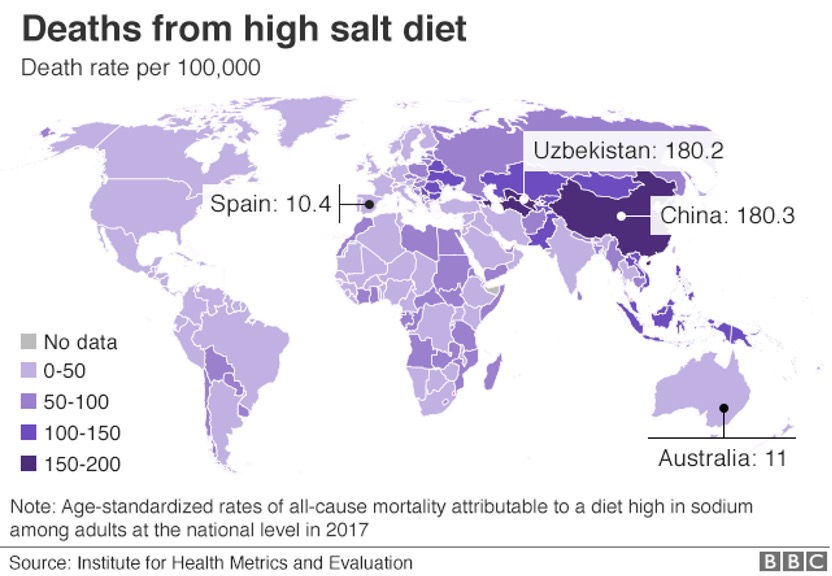Take it With a Grain of Salt
Believing everything that you read can be hazardous to your health

This Guy’s Favorite Condiment
"The diets cutting one in five lives short every year"
That was the headline that I saw when flipping through my news app a while back. https://bbc.com/news/health-47734296
I didn't want to be the "one" from the "five" so I figured it would be worth my while to read on.
As with most dietary studies, it mentioned that we should all be eating more fruits, vegetables, and nuts. We probably also ought to cool it on sugar and red meat. So far so good.
But then came the bombshell. The study's findings on the effect of dietary salt can be summarized in the following picture.

The study estimated that excessive salt consumption is the largest dietary killer on the planet, singlehandedly claiming 3 million lives per year. We even got a nice map so we can see where the unlucky victims live. 
I am NOT here to contradict teams of researchers. I am NOT saying that their facts are wrong. What I AM saying though is that many studies (and many news reports that summarize studies) seem to fall short in one crucial area.
That area is: guidance for how individuals should try to alter their behavior.
Most often, the take away from this type of study is that we all need to reduce our salt intake - especially if we live in China or Uzbekistan.
But in reality, nothing could be further from the truth. There are two reasons why:
Reason 1: The way that sodium intake is measured.
It is very difficult for researchers to follow people around all day and measure the sodium content of everything they put in their mouth. It is far easier to have the subjects pee into a cup. In fact, 24 hour urine collection is widely considered the golden standard for measuring sodium intake.
(click to see paper on methods for measuring sodium)
The problem with this method is that it only measures EXCESS sodium that a person flushes out in their urine. It ignores a very common human behavior:
SWEATING!
We all sweat different amounts and have widely varying salt content in our sweat.
For rough averages though, peak human sweat rate ranges from about 1 to 2 liters per hour.
Sodium content of sweat ranges from 500 to 2500mg of sodium per liter.
This means that an average individual sweating profusely will lose approximately 1650mg of sodium per hour with some people being able to excrete up to 5000mg of sodium per hour through their pores.
Compare this to the American Heart Association’s recommended ideal sodium intake of 1,500 mg per day, with a maximum of 2,300 mg per day.
Wait a minute! Did you read that correctly? Yes!
An average person can lose more salt through sweat in 1 hour, than the American Heart Association recommends consuming in an entire day!
It is quite probable, that many of the participants in sodium studies who have good cardiovascular health and low sodium content of urine (inferred by studies to mean a low sodium intake) actually consume high amounts of sodium.
The difference, is that they sweat most of it out through their pores, leaving very little to be flushed out in their urine. 
Following the American Heart Association’s recommendation of low sodium intake while exercising or working in a hot environment can quickly lead to hyponatremia (low blood sodium levels). This condition (characterized by headache, nausea, confusion, seizures, coma, and even death) affects between 3.2 million and 6.1 million persons in the U.S. annually and results in an annual health care burden of between $1.6 billion and $3.6 billion. Interestingly, as many as 20% of hospital patients (hospitals being one of the few places on earth where low sodium diets are enforced) suffer from hyponatremia.
(click to see paper on hyponatremia)
So if you are a sedentary office worker in Fairbanks, you might really pay attention to your salt intake. If you are a construction worker in Phoenix, you will probably live to see another bag of pretzels.
Reason 2: Salt affects people differently.
To clearly understand the second reason, it is helpful to consider the example of peanuts. Each year an estimated 150 to 200 people per year in the U. S. alone, die tragically from anaphylaxis as a result of peanut consumption. Does this mean that everybody should reduce their peanut consumption by 20% or 30%. ABSOLUTELY NOT! Peanuts can be deadly for the 0.6% of Americans who are allergic to them and should be avoided at all costs. The other 99.4% of Americans who are not allergic to peanuts should happily munch then down by the handful.
Salt has as similar story. Due to genetic factors, about 25% of Americans are sodium sensitive. This means that 1 person in 4 will experience increased blood pressure if excess sodium is consumed. The other 75% are much better able to simply flush out this excess sodium through their urine.
Should everybody strive to consume less salt? NO! 
The sodium sensitive population should reduce their salt intake. Meanwhile, the other three quarters of Americans should thank their parents for their good genes while reaching for the shaker.
So what is the moral of this story?
1-Failure to factor in the amount that a person sweats is not only grossly inaccurate but can even be dangerous.
2-Sodium consumption primarily causes hypertension in sodium sensitive individuals.
If you are sodium sensitive, and especially if you do not sweat very much, you should carefully watch your sodium intake. If you are not sodium sensitive, and especially if you sweat regularly, enjoy your French fries!
Whatever the case, the next time you see a news article summarizing a recent health study: take it with a grain of salt!
